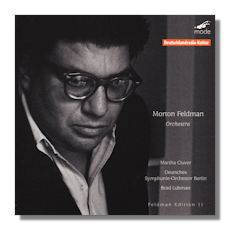
The Internet's Premier Classical Music Source
Related Links
- Feldman Reviews
- Latest Reviews
- More Reviews
-
By Composer
-
Collections
DVD & Blu-ray
Books
Concert Reviews
Articles/Interviews
Software
Audio
Search Amazon
Recommended Links
Site News
 CD Review
CD Review
Morton Feldman

Orchestra
- Intersection 1 (1951)
- Structures for Orchestra, (1960-1962)
- On Time and the Instrumental Factor (1969)
- Voice and Instruments (1972)*
- Orchestra (1979)
* Martha Culver, soprano
German Symphony Orchestra, Berlin/Brad Lubman
Mode mode238
Interest in and certainly recordings of the orchestral music of Morton Feldman (1926-1987) have not kept pace with the enthusiasm and exposure accorded to the composer's instrumental works. The invaluable Mode Records has just released a CD in collaboration with Deutschlandradio that goes a long way towards increasing the latter; and so hopefully the former. Volume 11 in their Feldman Edition, Orchestra, actually consists of a quarter of the composer's orchestral output… five works that were written in the quarter century or so from 1951 to 1979. Intersection I is the first recording of the version for full orchestra; the others are first recordings in their own right. Indeed, Voice and Instruments was written for the RIAS Symphonie-Orchester Berlin, now the Deutsches Symphonie-Orchester.
The listener will be struck immediately by the attack, yet the sensitive and fluid approach of the Deutsches Symphonie-Orchester Berlin under Brad Lubman. We're plunged straight away into the challenging soundscape of Samuel Clay Birmaher's realization of Intersection I [tr.1]. It was an interesting, and unusual process, which generated this piece: mindful of Feldman's aims to "[free] the sound and not the performer", Birmaher approached a number of contemporary composers asking them to play, spontaneously, from the unconventional score (a part of which is reproduced in the excellent, informative, booklet that comes with this CD). He then notated their performances in such a way that the orchestra's players could then perform as actors must when working with a script, even one they've worked up themselves. The raw, sinewy, uncompromising, unashamedly empirical compilation that results is indeed more of a series of intersections than instrumental collaborations. Yet the consonances which also still evolve are amply conveyed by the Deutsches Symphonie-Orchester. The same goes for the balance between what is clearly neither chaos nor provocative for all its novelty. It too leaves a positive impression.
Structures and On Time and the Instrumental Factor represent a period of transition in Feldman's music. Those familiar with the composer will be on well-trodden territory… long blocks of sound, pauses, echoes immediately back and references immediately and remotely forward. Suspended harmonies and tonalities. Lubman has the orchestra "toll" the music as much as play it. Each piece is shorter than the other three on the disk. The necessary compactness never sacrifices either beauty or a real sense of soul and space. But more significant is the extent to which the players search. Not an out loud rumination, nor an indulgent speculation. But the various sections of the orchestra engage in something of a journey. Most pleasing of all is that, as each of these two pieces progresses, the listener realizes that everyone involved including the listener themself probably knows the destination, the answer.
This theme of uncertainty to which if we can only find the key an equally certain outcome exists continues in Voice and Instruments. Here Feldman is as curious yet certain as anyone else… a sibylline voice is heard in concert with instruments. Here soprano Martha Culver is as finely attuned to the tenuousness of Feldman's conception as are the orchestral players. Not for a moment is there any hint at spurious or showy display. The wordless line is sound to a purpose. In common with the other works on this CD, though, Lubman and his musicians don't deprive us of atmosphere. We sense in Voice and Instruments in particular that these are recording "events". The engineers at these sessions in the Great Hall of the Haus des Rundfunks (there is a small typo in the booklet) in Berlin have gone a long way towards capturing particularly well the intensity and concentration of acoustic and ambience which Feldman's music needs.
Most pleasing of all, perhaps, is the way in which the Deutsches Symphonie-Orchester's sound and exposition are ones which are both inevitable and self-generating, while at the same time being full of purpose and direction. For all the apparent indeterminacy of Voice and Instruments and Orchestra, in particular, Feldman's music cannot be merely overheard and ignored. Specifically, Lubman has produced accounts which emphatically explore the qualities and potential of orchestral sound. At the same time these performances leave us with a more abstracted and distilled afterglow certainly at least a feeling of what music can achieve for us if… "left alone"! Orchestra hints at the directions which Feldman's music took in the last decade of his life.
This is a worthy and well-executed addition to the Feldman discography. Feldman's attitude to symphonic music, its composition and experience changed throughout his life. He came to see the limitations of conceiving of the orchestra as an instrument facing away from the listener. Hence, the task of this recording: at the same time both to present the music faithfully to Feldman's broadest vision; and to do so in ways accessible to an audience justifiably keen to believe in it: a "still life" must have a subject. These performers have amply succeeded in that task.
Copyright © 2011, Mark Sealey.




















